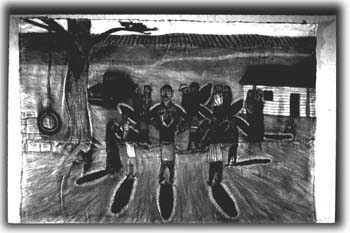![[Metroactive Arts]](/arts/gifs/art468.gif)
![[Metroactive Arts]](/arts/gifs/art468.gif)
[ Arts Index | Metro | Metroactive Central | Archives ]
Bound to the Earth
 Dance of Deliverance: A pastel-on-burlap record of the farm worker experience by Antonio Castro. Artists explore our use of the land By Ann Elliott Sherman THE LATEST group show at the Euphrat Museum of Art, Land Values, is intended to provoke thought about the broader social implications of our use, abuse and rehabilitation of land. The exhibit focuses on the importance of cultivating the soul food of a direct connection to the land. Looking for the Creek on Stevens Creek Blvd., an outdoor installation built from recycled castoffs by Susan Leibovitz Steinman and De Anza College students, finds its best moments when playing with paradox: wooden cribs protecting growing trees, shopping carts converted into planters. Marta Thoma plumbs the depths of our cultural remove from nature while subversively reasserting our inevitable connection to the earth. She wraps stuffed animals and dolls in electrical tape, then covers them in clay and soil to form "post-post-Columbian mummies." Nature reclaims its dominion in Thoma's enigmatic canvases, which layer historical photos with oils, encaustic and found objects. Images of children merge with natural elements that usually signify loss--their heads melded with fallen leaves or their hair drifting into wisps of smoke from a forest fire. The mix of historical fact and discarded manufactured objects with imagery that is simultaneously fanciful and disturbing lends an allegorical, fairy-tale quality to the narrative. Children, more closely connected to nature, are also ultimately uncontrollable and undervalued, Thoma suggests. Perhaps the most direct examination of the different values underlying one group's relationship to the land is Antonio Castro's series of drawings of farm workers done in pastel on the kind of brown burlap often used to bag root crops. Whether bowing to the demands of a short-handled hoe, packing lettuce in the field or dancing in the labor camp, the campesinos cast the radiant silhouette of the Virgen de Guadalupe on the land. Castro's use of that cultural symbol of La Raza is a resonant shorthand for the workers' spiritual link to the land and to each other. It is bit of a stretch to put Kehinde Wiley's Persistence of Memory--The Onion Series in the show, but these incredibly assured portraits set against an unrelenting landscape of dark earth and brooding sky hint at the character-forming effects of living in such a place. The larger painting positions two shirtless African American men in the foreground, with single brown onions suspended from string near them. Harshly lit from the front and staring stonily back at the viewer, they have no apparent connection to each other beyond their shared circumstance, differing drastically in physical stature and features. The shine on their skin suggests an oppressive humidity. The slender man has one of the strings wrapped around his finger--whether weighted by or controlling the onion is debatable. This is no romantic view of getting sustenance from the soil; by using an extremely narrow palette of nothing but brown, Wiley conveys the strictures of a colorless life, where wide-open spaces equate with godforsaken. THE PROBLEM of bringing noteworthy public art projects to a broader audience through documentation presented in a museum is that it always amounts to a secondhand experience. Though every effort is made to include the viewer in the entire process through photos, blueprints, field notes and the like, we ultimately end up being inspired by the idea, not the presented work. But the idea of reclaiming a vacant lot, scavenging the refuse as materials and joining with the people of the area to create an "Artpark" is strong inspiration, indeed. Tricia Ward led ARTScorpsLA and the neighborhood to make La Tierra de la Culebra, a space for ritual, contemplation and reconnection with the land that includes an amphitheater and stage, a ceremonial circle for Aztec dance and a 450-foot-long earth sculpture of a curving serpent incorporating river rock and tiles found during the cleanup. Similarly, Jun Maeda led Oakland youth in renovating a stage in drug-infested Arroyo Viejo Park for a production of the ARTSHIP Foundation featuring members of Augustino Dance Theatre and the community. On display here is part of a "basket mural" fashioned out of plants and sticks from the park and wrapped around the amphitheater. The ephemeral nature of the latter transformation makes it less impressive, but the Euphrat's continued exploration of ways art can make a difference in "the real world" is a valuable contribution to our cultural awareness.
Land Values runs through April 16 at the Euphrat, De Anza College, Cupertino (408/864-8836). [ Metro | Metroactive Central | Archives ]
| ||||||||||||||||||||||||||||||
This page was designed and created by the Boulevards team.
Copyright © 1997 Metro Publishing, Inc.